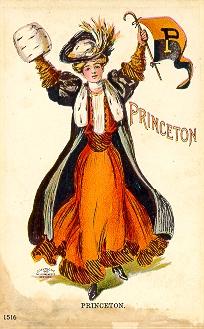
Romantic: marked by the imaginative or emotional appeal of what is heroic, adventurous, remote, mysterious, or idealized
– Merriam-Webster
It is old news that Princeton seems to embody, and even engender in its denizens, the essence of Romanticism, whatever that has come to be in the postmodern age. If there were any idealistic yearnings not planted by Witherspoon in the Continental Congress, Madison at the Constitutional Convention, Wilson in Paris, or Stevenson on the stump, they likely were carved in stone on campus by Ralph Adams Cram, Demetri Porphyrios *80, and their ilk. When Toni Morrison speaks in her 250th Anniversary Charter Day address about “The Place of the Idea; The Idea of the Place,” she emphasizes the constant and insistent renewal embodied by the very fabric of the University (genius loci to you, classicists!), but that in turn requires an unshakeable spirit of romantic optimism. Or so it seems to me.
So when I consider Romanticism in the (decidedly unromantic) 20th century, there appears little to compare with Princeton. With deference to such greats as Professor Morrison, whose stunning literary persona is far more complicated than merely Romantic, and Jose Ferrer Jr. ’34, whose Cyrano de Bergerac alone earns him mention, there seem to me three Tiger giants whose Romantic sensibilities cast a Princetonian Gothic shadow across the century and into the present.
The first, of course, is Scott Fitzgerald ’17, whose dream-world imagery of the Jazz Age – which he even named – will long outlive vestiges of Harding, Coolidge, and Herbert Hoover. It is sufficient to say that his epitaph, the last line of The Great Gatsby, brings back instantly memories of gargoyles and arch sings:
“So we beat on, boats against the current, borne back ceaselessly into the past.”
The second is Pete Carril, quite simply Don Quixote in sweatpants. In the modern rush to cash in on the superstar in everything from wall hangings to sneakers, he recalls us to the virtues of a visceral, other-oriented sensitivity that enable the Great Romantic Teams (like Cyrano and Roxane, Quixote and Dulcinea, George Leftwich and Kit Mueller). More on Pete later.
But third, and most arrestingly, there is the mysterious Gothic Romance of Henry Fairfax. The fair Princeton maidens who matriculated between 1974 and 1986 each knew him fleetingly, for on Valentine’s Day they would find an alluring hint of romance – well, to be technical, a little kindergarten-type “Be My Valentine” card or colorful limerick – personally signed by the gallant Henry beneath their door. What more could a potential Roxane hope for?
The legend of Henry Fairfax begins (as a significant proportion of legends do) with a sloshed undergraduate. Awakening foggily the morning after, young “Henry” recalled only his smittenness and the vague identity of the alluring smitter as either a freshman (Class of ’79) or sophomore (’78). To cover his bets, he surreptitiously delivered valentines to all their rooms on Feb. 14, 1976, perhaps planning to sort out the fervently hoped-for overflow later. Whether this worked or not, he decided to repeat the effort for the freshman women in 1977, and thus did befogged fixation become tradition.
Each year the new coeds would get their valentines, and each year the identity of the Cyrano wannabe (there is not now nor has there ever been a student named Henry Fairfax) would be debated and deferred. Nobody ever mentioned it to security or to the dean of students. Nobody ever claimed inside knowledge, and so the legend grew. By the ’80s, quality control seemed to suffer a bit – some messages were a bit steamy and/or crass; some years freshman men got Fairfaxed too (though not by “Henrietta”). But students came to expect the romantic tribute, until The Daily Princetonian decided the mystery was too tempting to ignore. On Feb. 14, 1987 (maybe the staff didn’t have the patience to wait and shoot the Easter Bunny), Prince photo editor Linda Ferguson ’88 caught Bob Dreyer ’87 red-carded as he delivered Henry’s missives. It seems the whole effort had become a sinecure of Charter Club’s seniors, who each year plotted carefully to continue the distribution. Thus deflated, that was the unceremonious end of beau Henry’s romantic mission, although where and how it began is still open to debate. Certainly, to know the alluring sirens of ’79 is to believe fervently in the most turgid version of the Henry Fairfax myth one can find.
Let us return to a romance with a happier denouement. On Feb. 21, Princeton will name the varsity basketball court for Pete Carril, the Great Romantic. This is a very good and proper thing, somewhat like naming the U.S. capital Washington, and to say it’s deserved is a hilarious understatement. You may recall that last year I wanted to get Pete onto the list of 250 greatest Princeton alumni, but was brusquely ignored by the editorial power structure hereabouts on the flimsy grounds that he’s not an alum. Well, how romantic is that?
Anyhow, this recognition will result in a nominal Ponzi scheme of sorts – the varsity floor now becomes Pete Carril Court on Jack Dorrance ’41 Courts in L. Stockwell Jadwin ’28 Gymnasium, but I think somehow we can all live with that. Someone else may someday win 266 games on this floor, but you and I certainly won’t be around to see it. Someone else may need to arise and save the little conferences’ NCAA tournament bids someday, but Pete’s the one who did it first (can it possibly be 20 years since the 49-50 “victory” over Georgetown?). The institutional value of having the vast majority of intelligent basketball people in the United States paying lip service (at least) to “the Princeton offense” is impossible to measure and impossible to buy. All of this is the legacy of a guy whose needs – a cigar, a pizza, and three or four people to listen to him in rotation – are ascetically slim, but whose influence and wisdom are romantically robust. Jadwin Gym: $ millions. Carril Court: $ thousands. Pete’s impact on Princeton: priceless.
Come on down to Jadwin Feb. 21 and see a Great Romance in person.












0 Responses